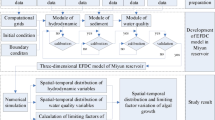Abstract
In this paper, an improved simulation method was developed to investigate the mechanisms of algal growth in Poyang Lake, which is the largest freshwater lake and the most typical river-connected lake in China. In view of its frequent water and sediment exchange with the external rivers, the influences of flow disturbance and suspended sediment concentration on algal growth were quantitatively analyzed based on field investigation and laboratory experiment, and the controlling equations of l(u) and g(S) were established and embedded into the traditional algal growth model for more accurate simulation in Poyang Lake. The improved model was calibrated and validated against the consecutive field monitoring data from March to November in 2012. By simulation, the algal concentration fluctuation in a common-water year and the spatial distribution under two typical current structures: “Gravity Style” and “Jacking Style,” were quantitatively estimated. The results showed that the improved model gave a good approximation of the algal growth processes under the varied water–sediment environment in Poyang Lake. Algal concentrations in the middle area were evidently higher than that in the south and north lake area, while the variation trends were basically the same. Due to the slower current, the algal concentration under “Jacking Style” flow structure was averagely increased by 18.8 % than that under the “Gravity Style.”









Similar content being viewed by others
References
Chen J (2009) Discussion on protection and utilization of the Yangtze River and river-connecting lakes. Yangtze River Scientific Research Institute Dalian Liaoning China TV213.4
Ding W, Chuai XM, Qian X, Hu ZX, Chu ZS, Yang LY (2011) Study of impact factor of forecasting algal bloom in Yanghe reservoir. Environ Monit Forewarning 3(4):1–5. doi:10.3969/j.issn.1674-6732.2011.04.001
Haag AL (2007) Algae bloom again. Nature 447(7144):520–521. doi:10.1038/447520a
He GJ, Fang HW, Bai S, Liu XB, Chen MH, Bai J (2011) Application of a three-dimensional eutrophication model for the Beijing Guanting Reservoir, China. Ecol Model 222(8):1491–1501
Hua G, Qi H, Qi Z (2011) Changes in hydrological interactions of the Yangtze River and the Poyang Lake in China during 1957–2008. Acta Geogr Sin 66(5):609–618
Jeong KS, Kim DK, Whigham B, Joo GJ (2003) Modelling Microcystis aeruginosa bloom dynamics in the Nakdong River by means of evolutionary computation and statistical approach. Ecol Model 161(1–2):67–78. doi:10.1016/S0304-3800(02)00280-6
Kirk JT (1983) Light and photosynthesis in aquatic ecosystem. Cambridge University Press, Cambridge
Pan JX (1960) Power of river dynamics. China Industry Press, Beijing
Qj Hu, Feng S, Guo H, Chen GY, Jiang T (2007) Interactions of the Yangtze river flow and hydrologic processes of the Poyang Lake, China. J Hydrol 347(1–2):90–100
Reinaldo G, Rene AK (1986) Numerical solution of the St. Venant equations with the MacComack finite-difference scheme. Numer Methods Fluids 6:259–274
Sha YQ (1965) Dynamics of sediment movement. China Industry Press, Beijing
Shi Y, Hu SY (2002a) A finite volume method for numerical modeling of 2-D flow and sediment movements on unstructured grids. J Hydrodyn 13(4):409–413
Shi Y, Hu SY (2002b) A finite volume method for numerical modeling of 2-D flow and sediment movements on unstructured grids. Adv Water Sci 13:409–413
Smetacke V (1991) Coastal eutrophication causes and consequences. In: Mantourd M (ed) Ocean margin processes in global change. Wiley, New York, pp 251–279
Sun P, Zhang Q, Chen XH (2011) Periodic properties and its implications of the sediment load and runoff changes of the Poyang Lake basin. J Wuhan Univ Nat Sci Ed 57(4):298–304
Tian F, Ge G, Yang C (2007) Research on HAB ecosystem model combining with hydrodynamics. Ocean Technol 26(2):34–37
Wan R, Yang GS, Wang XL, Qin LX, Dai X (2014) Progress of research on the relationship between the Yangtze River and its connected lakes in the middle reaches. J Lake Sci 26(1):1–8
Wang H, Pang Y (2008) Numerical simulation on hydrodynamic character for algae growth. Environ Sci 29(4):884–889
Wang H, Pang Y, Ding L, Liu M, Zhuang H (2008) Numerical simulations of the transparency of waterfront bodies. Tsinghua Sci Technol 13(05):720–729
Xu QJ, Qin BQ, Chen WM, Chen YW, Gao G (2001) Ecological Simulation of Algae Growth in Taihu Lake. Journal of Lake Science 13(2):149–157
Zhang YL, Qin BQ, Chen WM, Yang DT, Ji J (2003) Analysis on distribution and variation of beam attenuation coefficient of Taihu Lake’s water. Adv Water Sci 14(04):347–353. doi:10.3321/j.issn:1001-6791
Zhang YL, Qin BQ, Chen WM, Yang DT (2004) Regression analysis of beam attenuation coefficient under water in Lake Taihu. Oceanol Et Limnol Sin 35(03):209–213. doi:10.3321/j.issn:0029-814X.2004.03.003
Zhang GS, Xie F, Liang XH (2010) Indicators and methods for assessing aquatic ecosystem health. Chin Agric Sci Bull 26(24):334–337
Zhao DH, Shen HW, Lai JS, Tabios GQ (1996) Approximate Riemann solvers in FVM for 2D hydraulic shock wave modeling. J Hydraul Eng-ASCE 122(12):692–702
Zhao DH, Qi C, Yu WD, Xu BH, Pei ZP (2000) Finite-volume method and Riemann solver for depth-averaged two-dimensional flow-pollutants coupled model. Adv Water Sci 11(04):368–374. doi:10.3321/j.issn:1001-6791
Zhao DH, Shen FX, Yan ZJ, Lu GH (2004) A 2D sediment transport model based on the FVM with FDS for tidal rivers. J Hydrodyn 19(1):99–102
Acknowledgments
This work was supported by the National Natural Science Foundation of China (No. 51309082), the Major Science and Technology Program for Water Pollution Control and Treatment of China (Nos. 2012ZX07506-002 & 2012ZX07101-001) and A Project Funded by the Priority Academic Program Development of Jiangsu Higher Education Institutions.
Author information
Authors and Affiliations
Corresponding author
Rights and permissions
About this article
Cite this article
Wang, H., Zhang, Z., Deng, Y. et al. Algal growth simulation in fluctuating water–sediment circumstances of the largest river-connected lake in China. Environ Earth Sci 75, 66 (2016). https://doi.org/10.1007/s12665-015-4802-z
Received:
Accepted:
Published:
DOI: https://doi.org/10.1007/s12665-015-4802-z




